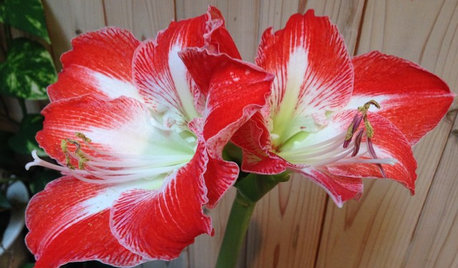Help! I Think my Amaryllis is dying!
macthayer
15 years ago
Related Stories

HOUSEPLANTSHow to Force Amaryllis Bulbs Indoors
Enjoy vibrant red blossoms even as gardens turn snowy white, by teaching this hardy repeat performer to ignore the calendar
Full Story
WINTER GARDENINGHow to Get an Amaryllis to Rebloom
Enjoy glorious flowers year after year just when you need them most, with this step-by-step strategy
Full Story
BATHROOM WORKBOOKStandard Fixture Dimensions and Measurements for a Primary Bath
Create a luxe bathroom that functions well with these key measurements and layout tips
Full Story
DECORATING GUIDESPro to Pro: Learn Your Client’s Thinking Style
Knowing how someone thinks can help you determine the best way to conduct an interior design presentation
Full Story
PETSHow to Help Your Dog Be a Good Neighbor
Good fences certainly help, but be sure to introduce your pup to the neighbors and check in from time to time
Full Story
MOST POPULAR9 Real Ways You Can Help After a House Fire
Suggestions from someone who lost her home to fire — and experienced the staggering generosity of community
Full Story
LIFEDecluttering — How to Get the Help You Need
Don't worry if you can't shed stuff and organize alone; help is at your disposal
Full Story
PETSSo You're Thinking About Getting a Dog
Prepare yourself for the realities of training, cost and the impact that lovable pooch might have on your house
Full Story
HOUSEKEEPINGWhen You Need Real Housekeeping Help
Which is scarier, Lifetime's 'Devious Maids' show or that area behind the toilet? If the toilet wins, you'll need these tips
Full Story


kaboehm (zone 9a, TX USA)
macthayerOriginal Author
Related Professionals
Norton Shores Landscape Architects & Landscape Designers · Garden City Landscape Architects & Landscape Designers · Forest City Landscape Architects & Landscape Designers · Clearlake Landscape Contractors · Cornelius Landscape Contractors · Fairfield Landscape Contractors · Lynchburg Landscape Contractors · Newnan Landscape Contractors · San Rafael Landscape Contractors · Stony Brook Landscape Contractors · Woodbury Landscape Contractors · North Aurora Landscape Contractors · Cedar Hill Swimming Pool Builders · Malden Swimming Pool Builders · Stanford Swimming Pool Buildersjodik_gw
macthayerOriginal Author
jodik_gw
sarmadsaeed_hotmail_com
elizabeth_jb
macthayerOriginal Author
jodik_gw
haxuan
macthayerOriginal Author
jodik_gw
mariava7
macthayerOriginal Author
java_j
jodik_gw
haxuan
jodik_gw